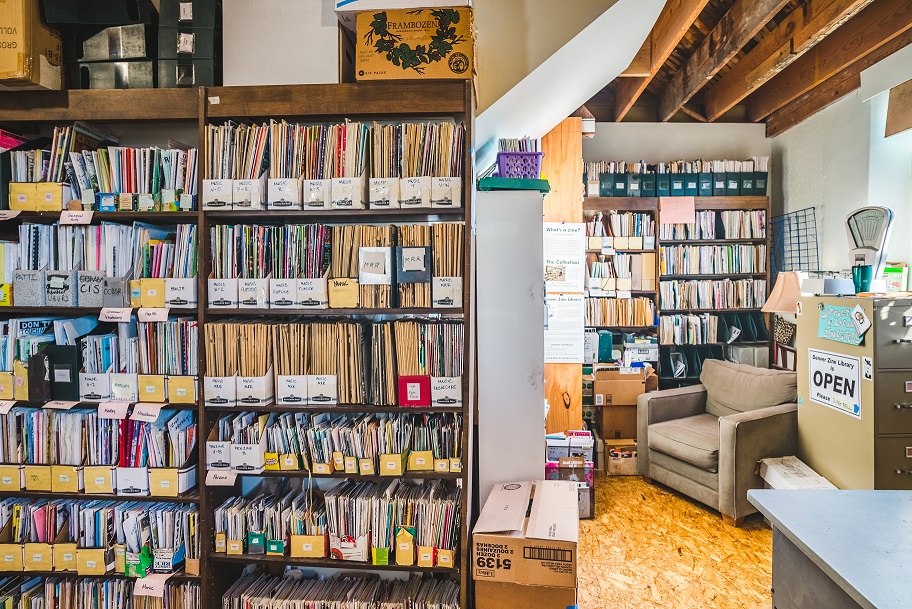Table of Contents Show
Fanzines (fan magazines) are one of the most vital structures to all of fandom. In the days before the internet or comic conventions, fanzines served as the source of communication and creation between fans. While fanzines can be traced back to the 1890s, they are most well known for being science fiction magazines such as Amazing Stories in 1926 and later becoming fandom zines like Spockanalia (a Star Trek zine) in 1968. These magazines would be produced by fans, containing short stories, fanfiction, artwork, reviews, and letters to the editor.

Printed editions of each fanzine would be sent through a mailing list, connecting thousands of fans who otherwise would be unable to communicate with each other. Though fanzines are still created and remain prevalent today, little attention has been paid to their potential. With social media now dominating the fandom sphere, printed fanzines no longer serve their original function as a communication hub for all fans. However, fanzines have been anything but replaced, and they continue to maintain a significant place in fandom.
Zines Are Always Evolving
The content and structure of fanzines are constantly evolving to meet the needs of their consumers. Earlier zines began as non-fiction publications so that fans could stay up to date on the latest news and gossip. Some of the earliest zines, such as The Baker Street Journal (a Sherlock Holmes zine), allowed fans to share scholarly insights or news surrounding the famous detective. Letterzines, a type of fanzine, later served as a collection of letters between fans who would discuss and debate their favorite fandoms. Zines composed of art and writing also became popular as a way for amateur creators to share their passions (both in and out of fandom).
These zines served as one of the only forms of communication between fans, especially for fans who did not live near each other. New issues would be printed and shipped nationwide to fans on a mailing list, thus allowing anyone to be a participant in fandom. Adzines were also created to act as advertisements of future zines that will be up for sale, allowing more fans to subscribe to mailing lists. With the advent of the internet, fans no longer needed zines to have large-scale communication. They could communicate on social media, while wikis and blogs served as the source for any fandom news. But rather than disappear entirely, fanzines changed to fit the times.

Now fanzines predominantly focus on fanart and fanfiction– and often come with specific themes like ships (romantic pairings). Fanzines also come in new formats like cookbooks focused around the food of a fictional universe or magazines and yearbooks that exist within the setting of the world. Some fanzines even come with extra merchandise like keychains and stickers to increase appeal! For many fans, zines still remain a constant source of information and communication. For the people who contribute to and make zines, they remain a place to make new friends and to share their passions. Zines also tend to provide the social media information for their contributors, encouraging online communication between the project’s creators and consumers.
Fanzines Make Money
For many people, fandom is both a source of entertainment and income. The sale of fanart and merchandise is a common business for fans, especially at conventions or online stores. Zines also serve as a source of income. Some fanzines are “for-profit,” meaning that their contributors will be paid a portion of the proceeds. It is also not uncommon for fans to create their own individual zines and sell them for profit online. Zine making is a promising business, as they provide opportunities for artists and writers to make some extra money.

However, not all zines are for profit. Charity zines have become common online, meaning that all the profits will be donated to a charity chosen by its contributors. It is not uncommon to see a successful fanzine raise thousands of dollars for a charity of their choosing. Fan activism, the employment of fandom for civic engagement or political participation, has become a driving force behind fanzines and proves to be a prominent signal for the power of fandom. Throughout Covid-19, fanzines served a special function in encouraging fandom-based income. Artists who were unable to attend conventions or struggled to sell their work online had an outlet to make and sell art alongside other fans. Charity zines also served a role in donating money to Covid relief funds as well as to social justice groups around the country and returning to the zine’s importance in 1960’s-1990’s political activism.
Zines Are Permanent Representations Of Fandom
As fandom delves further into the digital space, one thing we all worry about is if our favorite pieces of art and writing remain online. Fanworks often get deleted or lost, and websites will even shut down– removing entire chunks of fandom from the internet. However, printed works cannot be removed or deleted, and they offer a sense of what fandom looked like during a specific time in their history. Fanzines are a permanent collection of the things that mattered most to fans. Physical objects serve an important role in fandom, both for their ability to not be altered or removed but also for their emotional ties. Fanzines are like holding the emotional bonds people create with their fandoms in your hands! Collecting objects related to fandom is one of many ways to demonstrate your love and keep it forever!

Zine libraries around the country act as spaces to preserve and study the history of the zine for future generations. Organizations like Bowling Green State University’s Browne Popular Culture Library, The University of Urbana-Champaign Independent Media Center, and The University of Iowa Fanzine Archives offer a space to store, lend, and read fanzines. Zine libraries serve a special function in preserving fandom history, ensuring that both the source material and the fans are remembered for their hard work and dedication. The next time you have a fanzine you want to get rid of — consider donating it to a zine library!
How Do You Get Involved In Zine Culture?
Despite playing an important role in fandom, fanzines remain underrated. They are often forgotten, and sometimes fans don’t even know that fanzines are still in production! Fanartists and fanfiction writers often miss out on great opportunities to get involved in zines. As fanzines continue to evolve, it is important to promote their creation and sale. If you are looking to purchase a zine, consider checking out online zine blogs that, like their predecessor, the Adzine, provide information about zines currently for sale.
Or, if you want to participate, these blogs often include information on how to apply to be a writer or artist on a zine. Being a contributor requires no previous experience and is a great opportunity to learn more about zine culture and communities. If anything, promoting a zine requires nothing more than a reblog or a retweet. Fanzines are and always will be important to fandom culture and are worth preserving so that future fans can enjoy them!
